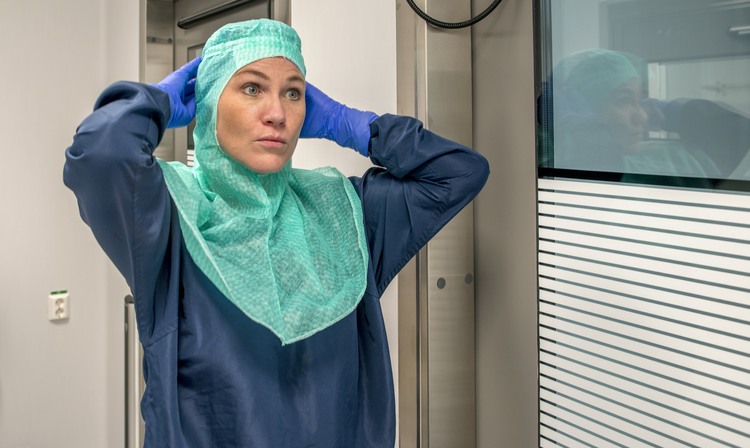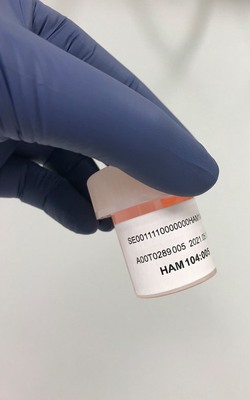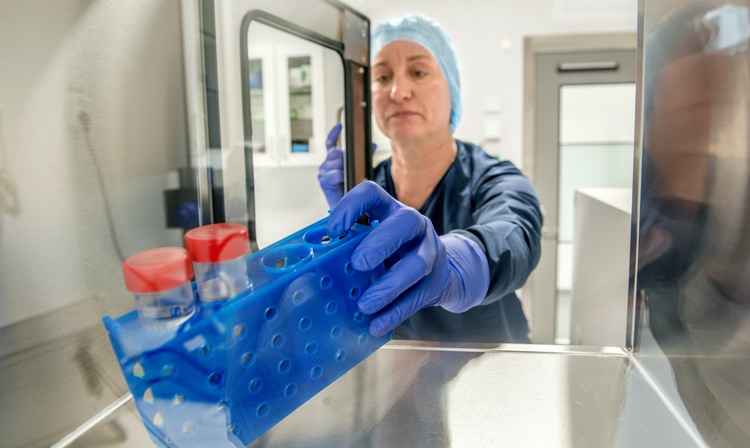Elin Norevik and Virpi Luoma, both biomedical scientists, work at St. Erik Eye Hospital’s tissue lab. Here they process and prepare donated placentas, as the foetal membranes surrounding them can be used as medical plasters in the treatment of eye injuries. They also prepare donated corneas for transplantations that enable patients with impaired vision to see again.
A patient can go from being almost blind to being able to drive again. It can have such an amazing impact on their quality of life, says Elin Norevik.
In conjunction with St. Erik Eye Hospital’s move to new premises in Solna, a new tissue lab was built with a higher cleanliness rating than the previous one. On their way to the clean room workbenches, Virpi and Elin pass through two airlocks, changing their clothes and shoes in each. Extremely low particle levels are needed in the lab where they work with donated eyes for cornea transplantations.

Elin Norevik changes her clothes and shoes in two separate airlocks before she can enter the lab.
Photo: Jens Sølvberg
Our work has become safer in the new premises. We minimise the risk of contamination, says Virpi Luoma.
The natural protective properties of the foetal membrane mean that it can be used for biological plasters. The donations are made via a collaboration with the specialist maternity clinic at Karolinska University Hospital in Huddinge, where some mothers donate the placenta following a planned caesarean section.
The collaboration with Karolinska University Hospital fulfils our needs for patients at St. Erik Eye Hospital. Any additional corneas are sent to other hospitals in Sweden, Virpi Luoma explains.

A donated placenta can produce 30–80 small biological plasters.
Photo: St. Erik Eye Hospital
To ensure that the tissues do not go to waste, Elin and Virpi have to work fast. The foetal membrane surrounding the placenta, also known as the amnion, is prepared and cut into small pieces. A single placenta can produce some 30 to 80 small amnion plasters, which can be frozen for up to a year.
In, for example, surgery on corrosive damage to an eye, the surgeon can place a piece of amnion on the eye. This promotes healing and can minimise any scarring, says Elin Norevik.
St. Erik Eye Hospital is one of five hospitals in Sweden – and the only one in Stockholm – that prepares donated eyes for transplantations. Since the corneas are outside the vascular system, they can be retrieved after death, although this still needs to be done within 48 hours. Even the white of the eye, the sclera, can be retrieved from a donated eye. This can be used, for instance, in surgery to treat patients with glaucoma.

Donated corneas must be tested and analysed before they can be approved for transplantation.
Photo: Jens Sølvberg
Once a corneal graft has been prepared, it is tested for, among other things, infection, which takes a few days. The grafts that are approved are then notified to the surgeon, who can call a patient on the long transplantation waiting list.

Donated corneas are stored in a refrigerator until transplantation.
Photo: Johanna Hanno
As corneas lack blood vessels, there’s little risk of rejection, says Virpi Luoma.
There is a great need for donated eye tissue. On average, the tissue lab receives about two pairs of eyes a week, but not all of them are approved for transplantation. The donors are often older people whose eyes have deteriorated with age. Sometimes, younger people who die in hospital have been so seriously ill that they are no longer suitable donors.
About another 100 suitable donors a year would cover the need for corneas. Many people perhaps don’t realise that they can donate their corneas, and the eye is a sensitive body part. However, a cornea transplant is sometimes the only option for patients with impaired vision, and a donation can completely change someone else’s life, says Elin Norevik.